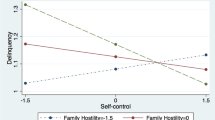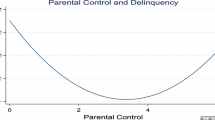Abstract
The purpose of the present study is to examine the racial disparities of offending within the context of self-control theory. The study utilized data from the National Longitudinal Survey of Youth (NLSY79), to examine this effect. All concepts within self-control theory are examined: parental management, low self-control, and delinquency. Results from the study show partial support for Gottfredson and Hirschi’s (1990) self-control theory. The structure of the theory remained stable when controlling for both race, as well as peer pressure. Both theoretical and policy implications are given.

Similar content being viewed by others
Notes
We acknowledge that Hirschi (2004) and Gottfredson (2006) have published parallel reconceptualizations of self-control. They have argued that researchers have spent too much time and resources examining something that they do not understand--low self-control. To alleviate this problem, they have redefined low self-control to self-control (i.e., the ability to foresee the consequences of one’s actions). With this redefinition, Hirschi (2004) and Gottfredson (2006) take two stances: 1) the characteristics are probably not necessary to understand self-control; thus, we present them here from a traditional perspective, and 2) the measurement of self-control differs by age but behavioral measures are still appropriate to use with juveniles.
These data have been used in other studies of Gottfredson and Hirschi’s (1990) theory (Beaver, Wright, DeLisi, & Vaughn, 2008; Chapple, 2005; Chapple & Hope, 2003; Hay, 2001; Hay & Forrest, 2008; Higgins, Kirchner, Ricketts, & Marcum, 2011; Nofziger, 2008; Pratt et al., 2004; Turner & Piquero, 2002; Wright & Cullen, 2001) suggesting that the data are appropriate for this study.
Complete information on our use of full information maximum likelihood estimation can be obtained by the second author on request.
This measure may not readily indicate monitoring but it does indicate expectations. The higher the levels of expectations the more likely the parents are paying attention (i.e., monitoring) to their child.
Given the size of the correlation matrix, the correlations are available from the second author on request.
References
Agnew, R. (1995). Testing the leading crime theories: an alternative strategy focusing on motivational processes. Journal of research in crime and delinquency, 32(4), 363–398.
Allison, P. (2003). Missing data techniques for structural equation modeling. Journal of Abnormal Psychology, 112(4), 545–557.
Beaver, K. M., Wright, J. P., DeLisi, M., & Vaughn, M. G. (2008). Genetic influences on the stability of low self-control: results from a longitudinal sample of twins. Journal of Criminal Justice, 36, 478–485.
Brame, R., & Paternoster, R. (2003). Missing data problems in criminological research. Journal of Quantitative Criminology, 19(1), 55–78.
Brame, R., & Piquero, A. R. (2003). Selective attrition and the age-crime relationship. Journal of Quantitative Criminology, 19, 107–128.
Brownfield, D., & Sorenson, A. M. (1993). Self-control and juvenile delinquency: theoretical issues and an empirical assessment of selected elements of a general theory of crime. Deviant Behavior, 14, 243–264.
Burt, C. H., Simons, R. L., & Simons, L. G. (2006). A longitudinal test of the effects of parenting and the stability of self-control: negative evidence for the general theory of crime. Criminology, 44, 353–396.
Chapple, C. (2005). Self-control, peer relations and delinquency. Justice Quarterly, 22(1), 89–106.
Chapple, C., & Hope, T. (2003). An analysis of the self-control and criminal versatility of dating and gang violence offenders. Violence and Victims, 18(6), 671–690.
Cohn, E., & Farrington, D. (1999). Changes in the most-cited scholars in twenty criminology and criminal justice journals between 1990 and 1995. Journal of Criminal Justice, 27, 345–359.
Enders, C. K. (2001). A primer on maximum likelihood algorithms available for use with missing data. Structural Equation Modeling, 8, 128–141.
Farrell, A. M. (2010). Insufficient discriminant validity: a comment on Bove, Pervan, Beatty, and Shiu (2009). Journal of Business Research, 63(3), 324–327.
Gibbs, J. J., Giever, D., & Higgins, G. E. (2003). A test of Gottfredson and Hirschi’s general theory using structural equation modeling. Criminal Justice and Behavior, 30, 441–458.
Gibbs, J. J., Giever, D., & Martin, J. S. (1998). Parental management and self-control: an empirical test of Gottfredson and Hirschi’s general theory. Journal of Research in Crime and Delinquency, 35, 40–70.
Giever, D. M. (1995). An empirical assessment of the core elements of Gottfredson and Hirschi’s general theory of crime. Indiana University of Pennsylvania). ProQuest Dissertations and Theses (pp. 174–174). Retrieved from http://search.proquest.com/docview/304246364?accountid=11652.(304246364).
Gottfredson, M. R. (2006). The empirical status of control theory in criminology. In F. T. Cullen, J. P. Wight, & K. R. Blevins (Eds.), Advances in criminological theory, vol. 15: Taking stock: The status of criminological theory (pp. 205–230). New Brunswick, NJ: Transaction.
Gottfredson, M. R., & Hirschi, T. (1990). A general theory of crime. Palo Alto, CA: Stanford University Press.
Grasmick, H. G., Tittle, C. R., Bursik, R. J., Jr., & Arneklev, B. J. (1993). Testing the core empirical implications of Gottfredson and Hirschi’s general theory of crime. Journal of Research in Crime and Delinquency, 30(1), 5–29.
Hay, C. (2001). Parenting, self-control, and delinquency: a test of self-control theory. Criminology, 39(3), 707–736.
Hay, C., & Forrest, W. (2008). Self-control and the concept of opportunity: the case for a more systematic union. Criminology, 46, 1039–1072.
Higgins, G. E. (2002). General theory of crime and deviance: a structural equation modeling approach. Journal of Crime and Justice, 25(2), 71–95.
Higgins, G. E., & Ricketts, M. L. (2005). Motivation or opportunity: which serves as the best mediator in self-control theory? Western Criminology Review, 5(2), 77–96.
Higgins, G. E., Kirchner, E. E., Ricketts, M. L., & Marcum, C. D. (2011). Developing self-control: the role of parental stress. Criminal Justice Studies: A Critical Journal of Crime, Law, and Society, 24, 183–199.
Hindelang, M. J., Hirschi, T., & Weis, J. G. (1981). Measuring delinquency. Beverly Hills: Sage Publications.
Hirschi, T. (2004). Self-control and crime. In R. F. Baumeister & K. D. Vohs (Eds.), Handbook of self-regulation: Research, theory and applications. New York: Guilford Press.
Hope, T. L., & Chapple, C. L. (2005). Maternal characteristics, parenting, and adolescent sexual behavior: the role of self-control. Deviant Behavior, 26(1), 25–45.
Hope, T. L., Grasmick, H. G., & Pointon, L. J. (2003). The family in Gottfredson and Hirschi’s general theory of crime: structure, parenting, and self-control. Sociological Focus, 36(4), 291–311.
Hu, L. T., & Bentler, P. M. (1999). Cutoff criteria for fit indexes in covariance structure analysis: conventional criteria versus new alternatives. Structural Equation Modeling: A Multidisciplinary Journal, 6(1), 1–55.
Junger, M., & Tremblay, R. (1999). Self control, accidents, and crime. Criminal Justice and Behavior, 26, 485–501.
Junger, M., West, R., & Timman, R. (2001). Crime and risky behavior in traffic: an example of cross-situational consistency. Journal of Research in Crime and Delinquency, 38, 439–459.
Kline, R. B. (2004). Principles and practice of structural equation modeling: Methodology in the social sciences (2nd ed.). New York, NY: Guilford Press.
LaGrange, T. C., & Silverman, R. A. (1999). Low self-control and opportunity: testing the general theory of crime as an explanation for gender differences in delinquency. Criminology, 37(1), 41–72.
LeBlanc, M. (1993). Late adolescence deceleration of criminal activity and development of self- and social control. Studies on Crime and Crime Prevention, 2, 51–68.
Longshore, D. (1998). Self-control and criminal opportunity: a prospective test of general theory of crime. Social Problems, 45(1), 102–114.
Longshore, D. & Turner, S. (1998). Self-control and criminal opportunity. Criminal Justice and Behavior, 25, 81–98.
Longshore, D., Turner, S., & Stein, J. A. (1996). Self-control in a criminal sample: an examination of construct validity. Criminology, 34, 209–228.
Meade, A. W., & Bauer, D. J. (2007). Power and precision in confirmatory factor analytic tests of measurement invariance. Structural Equation Modeling, 14(4), 611–635.
Muthén, B. O. (1989). Latent variable modeling in heterogeneous populations. Psychometrika, 54(4), 557–585.
Muthén, L. K., & Muthén, B. O. (2002). How to use a Monte Carlo study to decide on sample size and determine power. Structural Equation Modeling, 9(4), 599–620.
Nagin, D., & Paternoster, R. (1993). Enduring individual differences and rational choice theories of crime. Law & Society Review, 27, 467.
Nofziger, S. (2008). The cause of low self-control: the influence of maternal self-control. Journal of Research in Crime and Delinquency, 45(2), 191–224.
Perrone, D., Sullivan, C. J., Pratt, T. C., & Margaryan, S. (2004). Parental efficacy, self-control, and delinquency: a test of a general theory of crime on a nationally representative sample of youth. International Journal of Offender Therapy and Comparative Criminology, 48, 298–312.
Piquero, A. & Tibbetts, S. G. (1996). Specifying low self-control and situational factors in offender decision-making. Justice Quarterly, 31, 601–631.
Piquero, A. R., Farrington, D. P., Welsh, B. C., Tremblay, R., & Jennings, W. G. (2009). Effects of early family/parent training programs on antisocial behavior and delinquency. Journal of Experimental Criminology, 5(2), 83–120.
Piquero, A. R., Jennings, W. G., & Farrington, D. P. (2010). On the malleability of self-control: theoretical and policy implications regarding a general theory of crime. Justice Quarterly, 27(6), 803–834.
Polakowski, M. (1994). Linking self- and social control with deviance: illuminating the structure underlying a general theory of crime and its relation to deviant activity. Journal of Quantitative Criminology, 10, 41–78.
Pratt, T. C., & Cullen, F. T. (2000). The empirical status of Gottfredson and Hirschi’s general theory of crime: a meta-analysis. Criminology, 38, 931–964.
Pratt, T. C., Turner, M. G., & Piquero, A. (2004). Parental socialization and community context: a longitudinal analysis of the structural sources of low self-control. Journal of Research in Crime and Delinquency, 41, 219–243.
Tibbetts, S. G., & Gibson, C. L. (2002). Individual propensities and rational decision-making: Recent findings and promising approaches. In A. R. Piquero & S. G. Tibbetts (Eds.), Rational choice and criminal behavior: Recent research and future challenges. New York: Routledge.
Turner, M. G., & Piquero, A. R. (2002). The stability of self-control. Journal of Criminal Justice, 30, 457–471.
Unnever, J. D., Cullen, F. T., & Pratt, T. C. (2003). Parental management, ADHD, and delinquent involvement: reassessing Gottfredson and Hirschi’s general theory. Justice Quarterly, 20(3), 471–500.
Vazsonyi, A. T., & Crosswhite, J. M. (2004). A test of Gottfredson and Hirschi’s general theory of crime in African American adolescents. Journal of Research in Crime and Delinquency, 41(4), 407–432.
Vazsonyi, A. T., Pickering, L. E., Junger, M., & Hessing, D. (2001). An empirical test of a general theory of crime: a four-nation comparative study of self-control and the prediction of deviance. Journal of Research in Crime and Delinquency, 38(2), 91–131.
Winfree, L. T., & Bernat, F. P. (1998). Social learning, self-control, and substance abuse by eighth grade students: a tale of two cities. Journal of Drug Issues, 28, 539–558.
Wood, P. B., Pfefferbaum, B., & Arneklev, B. J. (1993). Risk-taking and self-control: social psychological correlates of delinquency. Journal of Crime and Justice, 16, 111–130.
Wright, J. P., & Beaver, K. M. (2005). Do parents matter in creating self-control in their children? A genetically informed test of Gottfredson and Hirschi’s theory of low self-control. Criminology, 43(4), 1169–1202.
Wright, L. W., Jr., & Cullen, J. (2001). Reducing college students’ homophobia, erotophobia, and conservatism levels through a human sexuality course. Journal of Sex Education & Therapy, 26, 328–334.
Author information
Authors and Affiliations
Corresponding author
Rights and permissions
About this article
Cite this article
Kirchner, E.E., Higgins, G.E. Self-Control and Racial Disparities in Delinquency: A Structural Equation Modeling Approach. Am J Crim Just 39, 436–449 (2014). https://doi.org/10.1007/s12103-013-9205-7
Received:
Accepted:
Published:
Issue Date:
DOI: https://doi.org/10.1007/s12103-013-9205-7




